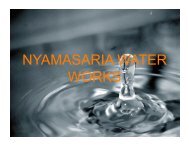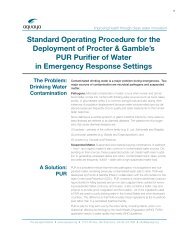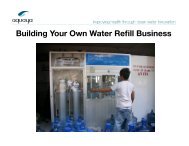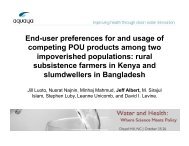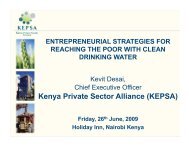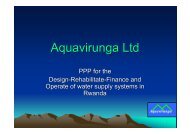Mobile data tools for improving information flow in WASH ... - Aquaya
Mobile data tools for improving information flow in WASH ... - Aquaya
Mobile data tools for improving information flow in WASH ... - Aquaya
Create successful ePaper yourself
Turn your PDF publications into a flip-book with our unique Google optimized e-Paper software.
<strong>Mobile</strong> <strong>data</strong> <strong>tools</strong> <strong>for</strong> <strong>improv<strong>in</strong>g</strong> <strong>in</strong><strong>for</strong>mation <strong>flow</strong> <strong>in</strong><br />
<strong>WASH</strong>: Lessons from three field pilots<br />
Authors<br />
Matt Ball 1 , Zarah Rahman 2 , Michael Champanis 3 , Ulrike Rivett 4 and Ranjiv Khush 5 1<br />
Abstract<br />
The application of <strong>in</strong><strong>for</strong>mation and communication technologies (ICT) to support the<br />
delivery of water and sanitation services is a grow<strong>in</strong>g area of <strong>in</strong>terest <strong>in</strong> the <strong>WASH</strong> sector.<br />
To study how these <strong>tools</strong> might be <strong>in</strong>corporated <strong>in</strong>to exist<strong>in</strong>g management structures, we<br />
conducted field pilots of a mobile phone based application <strong>for</strong> transmitt<strong>in</strong>g water quality<br />
<strong>data</strong> <strong>in</strong> three dist<strong>in</strong>ct water supply structures: a large prov<strong>in</strong>cial utility <strong>in</strong> Vietnam, rural<br />
NGO operations <strong>in</strong> Cambodia, and district health authorities <strong>in</strong> Mozambique. The use of the<br />
application improved the efficiency of <strong>in</strong><strong>for</strong>mation <strong>flow</strong>s <strong>in</strong> all three sett<strong>in</strong>gs, and <strong>in</strong>creased<br />
<strong>data</strong> availability at upper adm<strong>in</strong>istrative levels <strong>in</strong> Mozambique. Implement<strong>in</strong>g and troubleshoot<strong>in</strong>g<br />
the application revealed unexpected weaknesses <strong>in</strong> local cellular networks, and<br />
the requirement <strong>for</strong> clear phone management procedures. The limited <strong>in</strong><strong>for</strong>mation<br />
technology support services with<strong>in</strong> local <strong>in</strong>stitutions might favor external service providers<br />
to ensure the susta<strong>in</strong>ability of mobile applications, but we noted reluctance to develop<br />
<strong>for</strong>mal service relationships among participat<strong>in</strong>g <strong>in</strong>stitutions. Beneficial outcomes from the<br />
pilots <strong>in</strong>cluded <strong>in</strong>creased awareness among senior managers of monitor<strong>in</strong>g activities and of<br />
water quality <strong>data</strong>, and greater reflection upon <strong>data</strong> requirements and report<strong>in</strong>g methods<br />
by water quality units with<strong>in</strong> participat<strong>in</strong>g <strong>in</strong>stitutions.<br />
Introduction<br />
The potential <strong>for</strong> ICT <strong>tools</strong> to improve the quality and susta<strong>in</strong>ability of water and sanitation<br />
services <strong>in</strong> low-resource sett<strong>in</strong>gs is ga<strong>in</strong><strong>in</strong>g <strong>in</strong>creas<strong>in</strong>g attention (Hutch<strong>in</strong>gs et al. 2012).<br />
This <strong>in</strong>terest is driven by the often-successful application of digital <strong>tools</strong> <strong>in</strong> the health,<br />
agriculture and education sectors, and by the <strong>in</strong>creas<strong>in</strong>g availability and relative low cost of<br />
mobile phones. In Africa, <strong>for</strong> example, mobile phone penetration was approximately 65%<br />
<strong>in</strong> 2011 and is predicted to rise to over 85% by 2015 due to improved coverage and<br />
af<strong>for</strong>dability (Biosca 2012). A randomized controlled trial <strong>in</strong> Kenya has shown that text-<br />
1 The <strong>Aquaya</strong> Institute, 1004B O’Reilly Avenue, San Francisco, CA 94129 USA<br />
2 The <strong>Aquaya</strong> Institute, 1004B O’Reilly Avenue, San Francisco, CA 94129 USA<br />
3 iCOMMS, Department of Civil Eng<strong>in</strong>eer<strong>in</strong>g, University of Cape Town, Private Bag, Rondebosch, 7701, South<br />
Africa<br />
4 iCOMMS, Department of Civil Eng<strong>in</strong>eer<strong>in</strong>g, University of Cape Town, Private Bag, Rondebosch, 7701, South<br />
Africa<br />
5 The <strong>Aquaya</strong> Institute, 1004B O’Reilly Avenue, San Francisco, CA 94129 USA<br />
1
message rem<strong>in</strong>ders sent to health workers could improve their management of outpatient<br />
pediatric malaria (Zurovac et al. 2011). Broadly, mobile phone applications <strong>for</strong> public<br />
health have proven useful <strong>for</strong> connect<strong>in</strong>g remote groups with central operators, help<strong>in</strong>g to<br />
improve the turnaround time between <strong>data</strong> collection and report<strong>in</strong>g, <strong>in</strong>creas<strong>in</strong>g the<br />
accuracy of collected <strong>data</strong>, and reduc<strong>in</strong>g the cost of monitor<strong>in</strong>g programs (Conley et al.<br />
2010).<br />
In the <strong>WASH</strong> sector, ICT <strong>tools</strong> have been adopted on a limited scale to track the<br />
per<strong>for</strong>mance of NGO projects, to “crowd-source” <strong>in</strong><strong>for</strong>mation from the public on water<br />
supply function, and to report operational <strong>data</strong> from small dispersed water supplies<br />
(Hutch<strong>in</strong>gs et al. 2012; Thompson et al. 2012). For example, an ICT company <strong>in</strong> Senegal,<br />
Manobi SA, has developed the mWater mobile phone application <strong>for</strong> the Senegalese Water<br />
M<strong>in</strong>istry’s Operations & Ma<strong>in</strong>tenance division. mWater allows water utility managers to<br />
submit operational <strong>data</strong> <strong>for</strong> analysis and display through the <strong>in</strong>ternet (Gia & Fugelsnes<br />
2010). In Uganda, the National Water and Sewerage Corporation (NWSC) has partnered<br />
with different mobile network providers to implement ePayment, which is a facility <strong>for</strong><br />
pay<strong>in</strong>g water bills through mobile money direct remittances.<br />
The use of ICT <strong>tools</strong> and applications <strong>for</strong> <strong>WASH</strong> management <strong>in</strong> low resource sett<strong>in</strong>gs is<br />
likely to <strong>in</strong>crease, driven <strong>in</strong> part by the current emphasis on susta<strong>in</strong>ability monitor<strong>in</strong>g and<br />
by pressure to collect, process, and present more <strong>in</strong><strong>for</strong>mation <strong>for</strong> the benefit of the public,<br />
fund<strong>in</strong>g organisations, and regulatory agencies. This growth could prove quite rapid<br />
because many of the mobile <strong>tools</strong> developed <strong>for</strong> the health sector provide crossover<br />
functionality. These <strong>tools</strong> <strong>in</strong>clude the <strong>data</strong> gather<strong>in</strong>g systems provided by CommCare<br />
(DeRenzi et al. 2011) and the <strong>data</strong>-based alert functionality developed by RapidSMS<br />
(Ngabo et al. 2012).<br />
We seek to evaluate how mobile <strong>data</strong> <strong>tools</strong> can support <strong>WASH</strong> <strong>data</strong> collection and<br />
management. Experience from mobile health <strong>in</strong>itiatives suggests that open standards (Braa<br />
et al. 2010) and automated quality control (Birnbaum et al. 2012) are technical features<br />
that can promote smooth <strong>in</strong>tegration, but we must still identify the full range of steps<br />
necessary to ensure mobile <strong>data</strong> <strong>tools</strong> are effectively <strong>in</strong>tegrated <strong>in</strong>to <strong>WASH</strong> <strong>in</strong>stitutions.<br />
Additionally, identify<strong>in</strong>g the technical requirements to support mobile <strong>data</strong> <strong>in</strong>itiatives, and<br />
f<strong>in</strong>anc<strong>in</strong>g options <strong>for</strong> these projects, <strong>in</strong>clud<strong>in</strong>g tra<strong>in</strong><strong>in</strong>g of users and provision of long-term<br />
technical support, are vital <strong>for</strong> ensur<strong>in</strong>g long-term success.<br />
Methods<br />
In this study, we piloted a mobile phone based <strong>data</strong> report<strong>in</strong>g system <strong>in</strong> three dist<strong>in</strong>ct<br />
water sector contexts: with the Thua Thien Hue Water Supply and Construction Company<br />
(HueWACO) <strong>in</strong> Vietnam; with the non-governmental organisation, Teuk Saat 1001, <strong>in</strong><br />
Cambodia; and, <strong>in</strong> collaboration with UNICEF, with the M<strong>in</strong>istry of Health (MISAU), and the<br />
2
M<strong>in</strong>istry of Public Works’ National Directorate of Water (DNA) <strong>in</strong> Mozambique. This study<br />
was conducted as part of the Aquatest research program, an ef<strong>for</strong>t to develop low-cost<br />
microbial water quality test<strong>in</strong>g <strong>tools</strong> and <strong>data</strong> collection systems. The Aquatest programme<br />
was led by the University of Bristol, UK, and funded by the Bill & Mel<strong>in</strong>da Gates Foundation.<br />
Software solutions<br />
In each of the study sett<strong>in</strong>gs, we supported the configuration and use of the Water Quality<br />
Reporter (WQR) mobile phone application. This application operates on Java-enabled<br />
feature phones and is associated with a correspond<strong>in</strong>g backend web service, the Water<br />
Quality Manager (WQM) (Champanis & Rivett 2012). This system is based on an early<br />
version of the CommCare plat<strong>for</strong>m, a tool developed and ma<strong>in</strong>ta<strong>in</strong>ed by Dimagi Inc.<br />
(Cambridge, MA, USA) that <strong>in</strong>itially targeted <strong>data</strong> collection by community health workers<br />
and was adapted <strong>for</strong> water quality <strong>data</strong> report<strong>in</strong>g by the iCOMMs group at the University of<br />
Cape Town <strong>in</strong> South Africa. The WQR/WQM application was developed and ref<strong>in</strong>ed with<br />
<strong>in</strong>put from early users <strong>in</strong> South Africa prior to its use <strong>in</strong> this study. The WQR application<br />
presents a simple set of questions via <strong>for</strong>ms to end users, and the WQM provides <strong>for</strong>mgeneration<br />
services and retrieves and collates <strong>data</strong> from devices runn<strong>in</strong>g WQR. Data<br />
entered <strong>in</strong>to WQR <strong>for</strong>ms is transmitted to WQM via the mobile <strong>data</strong> (GPRS) network. If<br />
necessary, <strong>for</strong>ms can be saved to the phone until connectivity is available. Question types<br />
<strong>in</strong>clude free<strong>for</strong>m text entry, select one or many, and numerical <strong>in</strong>put, among others. WQM<br />
is hosted and ma<strong>in</strong>ta<strong>in</strong>ed by the iCOMMS group. Figure 1 illustrates the <strong>flow</strong> of <strong>in</strong><strong>for</strong>mation<br />
with<strong>in</strong> the WQR/WQM system and Figure 2 provides an example of a question on the WQR<br />
<strong>for</strong>m. The WQR application and WQM report<strong>in</strong>g protocols were configured with <strong>in</strong>put from<br />
managers and users <strong>in</strong> each of the three sett<strong>in</strong>gs. The three <strong>in</strong>stitutional partners were<br />
selected based on an evaluation of the potential applicability of the WQR/WQM system <strong>for</strong><br />
each context.<br />
Figure 1: The <strong>flow</strong> of <strong>data</strong> through the WQR/WQM<br />
3
Vietnam<br />
HueWACO is a large semi-autonomous water utility that serves twenty-two urban centers<br />
with<strong>in</strong> Hue prov<strong>in</strong>ce <strong>in</strong> central Vietnam. As part of their quality control program, operators<br />
at each of HueWACO’s satellite treatment plants collect water samples from the treatment<br />
plant and distribution networks and analyse these samples <strong>for</strong> eight physiochemical<br />
parameters. In addition to this on-site test<strong>in</strong>g, operators send weekly water samples to a<br />
central laboratory <strong>in</strong> Hue City where laboratory technicians conduct more complex<br />
analyses. In the pre-exist<strong>in</strong>g work<strong>flow</strong>, treatment plant operators compiled water quality<br />
<strong>data</strong> <strong>in</strong> hand-written logbooks, computed basic summary statistics (averages, m<strong>in</strong>imum<br />
and maximum values) and conveyed results to the company’s Quality Assurance Manager<br />
at the central laboratory via a weekly phone call. Operators also reported <strong>in</strong>ventory<br />
<strong>in</strong><strong>for</strong>mation <strong>for</strong> five water treatment chemicals and figures <strong>for</strong> daily water production.<br />
HueWACO’s goal <strong>in</strong> this project was to evaluate the use of mobile <strong>data</strong> <strong>tools</strong> <strong>for</strong> <strong>improv<strong>in</strong>g</strong><br />
the efficiency of this <strong>data</strong> report<strong>in</strong>g process. The Quality Assurance Manager selected<br />
sixteen of the twenty-two treatment plants <strong>for</strong> participation.<br />
Figure 2: An example question<br />
ask<strong>in</strong>g <strong>for</strong> pH test<strong>in</strong>g values from the<br />
Vietnamese WQR <strong>for</strong>m.<br />
Cambodia<br />
Teuk Saat 1001 is a Cambodian non-profit organisation that<br />
partners with local communities to develop and manage<br />
rural water treatment and vend<strong>in</strong>g kiosks. Under Teuk Saat<br />
1001’s model, local operators/entrepreneurs oversee<br />
simple purification systems and sell bulk bottled water at<br />
an af<strong>for</strong>dable price to community members. The operators<br />
carry out regular basic bacteriological water quality tests<br />
and compile test results, along with other <strong>data</strong> on system<br />
operations and sales, <strong>in</strong> logbooks. Staff from the Teuk Saat<br />
1001 central office travel to each rural site approximately<br />
once a month to provide technical support visits and collect<br />
logbooks. The collation and report<strong>in</strong>g of the large number<br />
of test results is a time-consum<strong>in</strong>g ef<strong>for</strong>t and Teuk Saat<br />
1001 managers only receive <strong>data</strong> approximately once every<br />
month. The managers were <strong>in</strong>terested <strong>in</strong> more rapid access<br />
to tests results and sales <strong>data</strong> and <strong>in</strong> <strong>tools</strong> that could<br />
improve the efficiency of collat<strong>in</strong>g <strong>data</strong> <strong>for</strong> donor report<strong>in</strong>g.<br />
They selected ten operators to pilot the mobile phonebased<br />
<strong>data</strong> collection system.<br />
Mozambique<br />
District environmental health technicians <strong>in</strong> Mozambique play a central role <strong>in</strong> monitor<strong>in</strong>g<br />
rural dr<strong>in</strong>k<strong>in</strong>g water supplies; their responsibilities <strong>in</strong>clude both water quality test<strong>in</strong>g and<br />
source <strong>in</strong>spections. With the support of UNICEF’s One Million Initiative, a large rural <strong>WASH</strong><br />
4
improvement program, environmental health technicians <strong>in</strong> selected districts were<br />
provided with portable water quality test<strong>in</strong>g kits and other resources to support this<br />
monitor<strong>in</strong>g activity. Their results are recorded <strong>in</strong> paper logbooks and records are only<br />
ma<strong>in</strong>ta<strong>in</strong>ed <strong>in</strong> district health offices. In this study, we collaborated with UNICEF and<br />
responsible government agencies to <strong>in</strong>corporate mobile phone based <strong>data</strong> record<strong>in</strong>g and<br />
report<strong>in</strong>g <strong>in</strong>to water quality monitor<strong>in</strong>g activities <strong>in</strong> six districts. Data submitted us<strong>in</strong>g the<br />
mobile phones was sent via email to senior adm<strong>in</strong>istrators at the district, prov<strong>in</strong>cial and<br />
national levels.<br />
Implementation<br />
Figure 3: Example graph from the Mozambique water<br />
quality report show<strong>in</strong>g the percentage of samples that<br />
exceed acceptable limits <strong>for</strong> microbial water quality.<br />
In order to <strong>in</strong>tegrate the WQR/WQM system<br />
<strong>in</strong>to exist<strong>in</strong>g <strong>in</strong>stitutional processes, relevant<br />
managers were asked to def<strong>in</strong>e their <strong>data</strong><br />
report<strong>in</strong>g requirements, <strong>in</strong>clud<strong>in</strong>g desired<br />
<strong>for</strong>m content. Hardware was distributed and<br />
<strong>for</strong>ms and report<strong>in</strong>g features were configured<br />
to support stated needs. The questionnaires<br />
developed <strong>for</strong> the mobile <strong>in</strong>terface often made<br />
use of the same structure as the paper <strong>for</strong>ms<br />
and no new staff members were recruited <strong>in</strong>to<br />
report<strong>in</strong>g roles. Local languages were also used<br />
<strong>in</strong> Vietnam and Mozambique, though this was<br />
not possible <strong>in</strong> Cambodia because the phone<br />
application was unable to support the Khmer<br />
script. To support the shift to mobile devices,<br />
end-users were tra<strong>in</strong>ed and troubleshoot<strong>in</strong>g<br />
support was provided. After an <strong>in</strong>itial trial<br />
period, modifications and improvements were<br />
made to the <strong>for</strong>ms and report<strong>in</strong>g configuration based on user feedback.<br />
The <strong>data</strong> collected by WQR was delivered to managers <strong>in</strong> various ways. The WQM<br />
application was designed with very basic report<strong>in</strong>g functionality because of an <strong>in</strong>itial<br />
prioritisation of the design of the <strong>data</strong> collection aspect of the system. The WQM system can<br />
collate and email raw <strong>data</strong> (<strong>in</strong> excel or cvs files). In Vietnam, the HueWACO Quality<br />
Assurance Manager opted to receive a weekly email with raw <strong>in</strong><strong>for</strong>mation. Her staff were<br />
then responsible <strong>for</strong> comb<strong>in</strong><strong>in</strong>g <strong>data</strong> received through the WQR/WQM system with other<br />
relevant <strong>data</strong>, <strong>for</strong> example, test results from the central laboratory, and <strong>for</strong> compil<strong>in</strong>g<br />
reports <strong>for</strong> regulatory authorities. In Cambodia, Teuk Saat 1001 managers received a<br />
similar weekly update with the reported values from their WQR-equipped operators.<br />
Managers and field staff <strong>in</strong> Mozambique requested a more complex report<strong>in</strong>g <strong>for</strong>mat, <strong>in</strong><br />
5
which <strong>data</strong> summaries could be provided to supervisors at upper adm<strong>in</strong>istrative levels.<br />
Additional ef<strong>for</strong>ts were made to develop an Excel macro <strong>for</strong> generat<strong>in</strong>g such reports. The<br />
macro was used to compute several broad statistics, render graphs and display a map to<br />
illustrate the weekly and monthly test results (Figure 3). <strong>Aquaya</strong> manually generated<br />
several reports of this type us<strong>in</strong>g the macro on weekly and monthly schedules, with each<br />
be<strong>in</strong>g delivered to different sets of relevant stakeholders. For <strong>in</strong>stance, weekly reports<br />
from a specific prov<strong>in</strong>ce were distributed to technicians and managers <strong>in</strong> that region and to<br />
UNICEF staff; monthly program-wide reports were be sent to all parties, <strong>in</strong>clud<strong>in</strong>g national<br />
adm<strong>in</strong>istrators.<br />
Data collection<br />
Interviews and <strong>in</strong><strong>for</strong>mal conversations were held with managers and end-users from the<br />
three organisations dur<strong>in</strong>g all phases of the deployment of the mobile <strong>data</strong> <strong>tools</strong>. These<br />
discussions centered on the perceived utility of the system and on strategies <strong>for</strong> manag<strong>in</strong>g<br />
and ma<strong>in</strong>ta<strong>in</strong><strong>in</strong>g consistent use of the <strong>tools</strong>. The reported <strong>data</strong> itself was regularly<br />
reviewed to analyse the operational status of the programs. Stakeholders <strong>in</strong> the various<br />
<strong>in</strong>stitutions are not identified by name to protect their privacy. Data submitted to the<br />
system was stored <strong>in</strong> a secure fashion to prevent unauthorised access.<br />
Results and discussion<br />
Impact of <strong>in</strong>troduc<strong>in</strong>g mobile <strong>data</strong> <strong>tools</strong><br />
The use of mobile <strong>data</strong> <strong>tools</strong> can improve the consistency and efficiency with which<br />
decentralised agents report monitor<strong>in</strong>g <strong>data</strong>. In the case of Mozambique, <strong>data</strong> collected by<br />
district health and water technicians was previously ma<strong>in</strong>ta<strong>in</strong>ed only <strong>in</strong> paper logbooks at<br />
the district level. As a result, prov<strong>in</strong>cial and national level officials, and even senior district<br />
level officials, had limited access to <strong>in</strong><strong>for</strong>mation on how monitor<strong>in</strong>g programs were be<strong>in</strong>g<br />
implemented and to results from such monitor<strong>in</strong>g. We have observed similar gaps <strong>in</strong><br />
availability of water source monitor<strong>in</strong>g <strong>data</strong> at upper adm<strong>in</strong>istrative levels <strong>in</strong> other<br />
countries, <strong>in</strong>clud<strong>in</strong>g Ecuador, Bolivia and Sri Lanka (Rahman & Khush 2012). With the<br />
<strong>in</strong>troduction of the mobile phone report<strong>in</strong>g system <strong>in</strong> Mozambique, field technicians<br />
submitted over 1000 <strong>for</strong>ms us<strong>in</strong>g WQR <strong>in</strong> just over a year and this field <strong>data</strong> was made<br />
available, <strong>for</strong> the first time, to decision-makers at multiple adm<strong>in</strong>istrative levels. These<br />
results represented a significant improvement <strong>in</strong> <strong>data</strong> availability.<br />
The improvements <strong>in</strong> overall <strong>data</strong> availability were less significant <strong>for</strong> HueWACO and Teuk<br />
Saat 1001, each of which already had effective systems <strong>in</strong> place <strong>for</strong> obta<strong>in</strong><strong>in</strong>g <strong>data</strong> from<br />
their satellite water systems. In the case of Vietnam, the central laboratory was already<br />
obta<strong>in</strong><strong>in</strong>g <strong>data</strong> from satellite treatment plants through weekly phone calls. HueWACO’s<br />
demonstrated commitment to <strong>data</strong> report<strong>in</strong>g is likely a result of sector regulations; <strong>in</strong><br />
Vietnam and many other countries, regulations require water service providers such as<br />
6
HueWACO to demonstrate water quality compliance by provid<strong>in</strong>g <strong>data</strong> summaries to<br />
oversight agencies. Where en<strong>for</strong>cement of such regulatory requirements is strong, there is<br />
external pressure <strong>for</strong> utilities that operate numerous satellite systems to obta<strong>in</strong> and<br />
manage <strong>in</strong>ternal <strong>data</strong> despite the <strong>in</strong>herent logistical challenges. NGOs such as Teuk Saat<br />
1001 also generally have strict requirements <strong>for</strong> report<strong>in</strong>g program outputs to funders.<br />
Nevertheless, even where the mandate or desire to obta<strong>in</strong> <strong>data</strong> from field sites is strong,<br />
logistical limitations do affect the efficiency of report<strong>in</strong>g. For example, Teuk Saat 1001<br />
sends staff from their central office to each of their remote sites to collect paper <strong>for</strong>ms. Due<br />
to the distances <strong>in</strong>volved and the transportation and human resources required, they are<br />
only able to undertake these <strong>data</strong> collection visits once a month. Us<strong>in</strong>g WQR, <strong>data</strong> was sent<br />
as soon as it was obta<strong>in</strong>ed, giv<strong>in</strong>g managers the ability to monitor numerous rural sites <strong>in</strong><br />
nearly real-time. In the case of Teuk Saat 1001, managers at the central office <strong>in</strong>dicated that<br />
such real-time <strong>data</strong> availability enabled them to provide immediate support to rural<br />
operators if water quality <strong>data</strong> <strong>in</strong>dicated failures <strong>in</strong> the treatment systems. There were no<br />
specific examples, however, of such real-time support dur<strong>in</strong>g this project implementation.<br />
Implementation Challenges<br />
Experience from these pilots <strong>in</strong>dicates that mobile <strong>data</strong> systems can be difficult to<br />
implement and ma<strong>in</strong>ta<strong>in</strong> by local actors. Common challenges related to network<br />
connectivity, phone and application sett<strong>in</strong>gs and phone management.<br />
Technical Challenges<br />
Across the three project sites, the cellular <strong>data</strong> network was weak <strong>in</strong> some locations, even<br />
when there was sufficient bandwidth <strong>for</strong> voice calls. As a result, several attempts were<br />
often required be<strong>for</strong>e <strong>data</strong> was successfully submitted. Although network connectivity<br />
issues came up across all sett<strong>in</strong>gs, they were especially prom<strong>in</strong>ent <strong>in</strong> Mozambique, where<br />
the connectivity was extremely poor <strong>in</strong> one of the three program prov<strong>in</strong>ces. Although<br />
delayed submission did not fundamentally underm<strong>in</strong>e the monitor<strong>in</strong>g programs, this poor<br />
network reliability frustrated technicians and reduced their confidence <strong>in</strong> the system. In<br />
cases where connectivity was especially poor, some technicians quickly stopped us<strong>in</strong>g their<br />
mobile phones to submit <strong>data</strong>. Data connectivity also delayed the transmission of<br />
confirmation messages, which confused users and caused them to send duplicate <strong>data</strong>.<br />
WQR bundles and sends <strong>in</strong><strong>for</strong>mation entered <strong>in</strong>to a <strong>for</strong>m over the packet <strong>data</strong> network.<br />
This process requires a specific phone sett<strong>in</strong>gs configuration. In all three pilot sites, the<br />
required configuration was sometimes lost, prevent<strong>in</strong>g WQR from connect<strong>in</strong>g to the<br />
system's servers. We suspect that network configuration was lost when users switched<br />
SIM cards, manually changed sett<strong>in</strong>gs, or exhausted their airtime credit. Users <strong>in</strong> all sett<strong>in</strong>gs<br />
were approximately equal <strong>in</strong> their familiarity with us<strong>in</strong>g mobile phones, and none were<br />
previously familiar with processes <strong>for</strong> configur<strong>in</strong>g phones <strong>for</strong> network access. In addition,<br />
7
they were not sufficiently tra<strong>in</strong>ed under this project to identify configuration errors. As a<br />
result, technical setbacks such as these sometimes kept users from send<strong>in</strong>g <strong>data</strong> until<br />
managers could provide assistance, which could take several weeks.<br />
Management challenges<br />
Our study identified the importance of establish<strong>in</strong>g clear overall management procedures<br />
<strong>for</strong> phone usage. In some pilot sites, managers failed to establish processes <strong>for</strong> purchas<strong>in</strong>g<br />
additional phone credit. Although send<strong>in</strong>g <strong>for</strong>ms costs very little, users frequently ran out<br />
of credit, either because they made both personal or professional voice calls or because<br />
their credit expired. The <strong>in</strong>consistency <strong>in</strong> submissions that resulted from poor<br />
connectivity, changes <strong>in</strong> phone sett<strong>in</strong>gs and lack of phone credit is illustrated <strong>in</strong> Table 1.<br />
Table 1: WQR Submissions by District, Mozambique<br />
2011 2012<br />
District<br />
may june july aug sept oct nov dec jan feb mar<br />
apri<br />
l<br />
may june july aug<br />
Total<br />
Guro 4 2 42 11 1 60<br />
Manica 7 3 24 3 13 14 27 28 30 28 177<br />
Angonia 1 15 9 15 3 32 34 31 31 171<br />
Gorongosa 1 1 4 6 11 28 30 26 36 27 30 32 43 16 30 11 332<br />
Nhamatand<br />
a 41 40 60 23 34 30 21 11<br />
260<br />
Tsangano 0<br />
Total 2 16 13 28 11 35 95 69 111 109<br />
10<br />
2 90<br />
12<br />
7 78 72 42<br />
1000<br />
Observations made dur<strong>in</strong>g field visits also suggested that many of the participants used the<br />
WQR phones <strong>for</strong> personal use. While not necessarily problematic, personal use can lead to<br />
damaged or lost phones, changes to the phones’ sett<strong>in</strong>gs, and overuse of the phone memory<br />
(which can also affect application functionality). To avoid program disruption due to<br />
personal phone use, managers must be prepared to establish clear rules regard<strong>in</strong>g phone<br />
usage when implement<strong>in</strong>g mobile <strong>data</strong> report<strong>in</strong>g programs.<br />
8
Implications<br />
The technical and managerial challenges noted above had several consequences: managers<br />
were unable to rely completely on WQR <strong>for</strong> <strong>data</strong> collection; managers were unable to<br />
differentiate between technical failures and true lapses <strong>in</strong> monitor<strong>in</strong>g; and field staff<br />
became frustrated with the system. The ubiquity of these challenges suggests the need <strong>for</strong><br />
work<strong>flow</strong>s that allow <strong>for</strong> <strong>in</strong>termittent failure of the technology. For example, after several<br />
months, we established a work<strong>flow</strong> <strong>in</strong> Vietnam where the Quality Assurance Manager<br />
received a scheduled alert that listed sites that had not yet reported <strong>for</strong> the week. The<br />
manager was then able to respond efficiently by call<strong>in</strong>g the operators at these specific sites<br />
to obta<strong>in</strong> the miss<strong>in</strong>g <strong>data</strong>. Technical solutions such as an automated, regular signal from<br />
the phone that <strong>in</strong>dicates whether the application is operational could also help dist<strong>in</strong>guish<br />
between technical problems and user per<strong>for</strong>mance. In addition, dedicated project<br />
managers should be available <strong>for</strong> <strong>in</strong>tensive troubleshoot<strong>in</strong>g dur<strong>in</strong>g the <strong>in</strong>itial launch period.<br />
F<strong>in</strong>ally the cost effectiveness of such <strong>in</strong>tensive program management should also be<br />
evaluated.<br />
Long term service provision<br />
Appropriate long terms strategies are also required <strong>for</strong> manag<strong>in</strong>g the software <strong>tools</strong><br />
themselves. In these pilots, partner organisations were not responsible <strong>for</strong> <strong>for</strong>m<br />
development and system host<strong>in</strong>g. While consultants can generally be employed to assist<br />
with the <strong>in</strong>itial configurations and deployment of a mobile <strong>data</strong> tool, system host<strong>in</strong>g is more<br />
challeng<strong>in</strong>g to manage. Java and Android questionnaire applications can be deployed us<strong>in</strong>g<br />
at least two options: 1) a local <strong>in</strong>stitution can obta<strong>in</strong> the software source code and fully host<br />
and manage the application; or 2) an external actor can provide the application as a service<br />
and manage both host<strong>in</strong>g and ma<strong>in</strong>tenance. As an example of this second option, the<br />
CommCare application, from which the WQR/WQM system was orig<strong>in</strong>ally derived, is now<br />
available as a service: users can create accounts, build <strong>for</strong>ms, deploy the software and<br />
manage <strong>in</strong>com<strong>in</strong>g <strong>data</strong> through a web <strong>in</strong>terface. Dimagi Inc. hosts the <strong>data</strong> and ma<strong>in</strong>ta<strong>in</strong>s<br />
the required servers. They also offer different service levels, with basic deployments<br />
supported <strong>for</strong> free and fees applied <strong>for</strong> larger scale programs. We have observed that<br />
government agencies <strong>in</strong> develop<strong>in</strong>g countries generally have limited capacity to host and<br />
ma<strong>in</strong>ta<strong>in</strong> these types of applications. They also appear to be <strong>in</strong>stitutionally unprepared to<br />
utilise the ‘Software as a Service’ model.<br />
The costs of implement<strong>in</strong>g and ma<strong>in</strong>ta<strong>in</strong><strong>in</strong>g mobile <strong>data</strong> solutions are not <strong>in</strong>significant. In<br />
this study we purchased a dedicated phone <strong>for</strong> each participat<strong>in</strong>g user, with phone prices<br />
rang<strong>in</strong>g from USD 70 - 120 per phone. We avoided the use of personal phones due to the<br />
technical challenges of <strong>in</strong>stall<strong>in</strong>g the WQR software and configur<strong>in</strong>g network sett<strong>in</strong>gs on a<br />
variety of phone makes and models. Due to the nature of the WQM <strong>in</strong>terface, a software<br />
development expert was required to create the <strong>in</strong>stitution specific phone-based <strong>data</strong> entry<br />
<strong>for</strong>ms <strong>for</strong> this study. However, similar questionnaire applications such as CommCare, now<br />
9
provide user-friendly <strong>for</strong>m build<strong>in</strong>g <strong>in</strong>terfaces that can be navigated by non-technical<br />
users. In this study we allocated significant time to assess<strong>in</strong>g <strong>in</strong>stitutional <strong>in</strong><strong>for</strong>mation<br />
report<strong>in</strong>g needs and to translat<strong>in</strong>g those needs <strong>in</strong>to the phone-based <strong>for</strong>ms. Similar<br />
external assistance will likely be required <strong>for</strong> many <strong>in</strong>stitutions.<br />
We do not have sufficient <strong>data</strong> to directly compare the costs of us<strong>in</strong>g the mobile <strong>data</strong><br />
system with costs of traditional report<strong>in</strong>g mechanisms. We suspect that the primary<br />
expense of HueWaco and Teuk Saat 1001’s previous <strong>data</strong> collection system was the time<br />
spent manually enter<strong>in</strong>g <strong>data</strong>. For both HueWACO and Teuk Saat 1001, the direct costs of<br />
transmitt<strong>in</strong>g <strong>data</strong> were negligible: <strong>in</strong> HueWACO, this was done by voice calls, and Teuk Saat<br />
1001 staff collected logbooks dur<strong>in</strong>g scheduled site visits that <strong>in</strong>cluded other activities. In<br />
the case of Mozambique, <strong>data</strong> was not previously reported upwards from district health<br />
offices nor was it digitised or analysed. In summary, the benefits of improved <strong>data</strong> <strong>flow</strong><br />
and <strong>data</strong> availability with respect to <strong>WASH</strong> service provision have to be evaluated and<br />
quantified to determ<strong>in</strong>e the cost-effectiveness of mobile <strong>data</strong> report<strong>in</strong>g.<br />
Benefits of Improved In<strong>for</strong>mation Flow and maximis<strong>in</strong>g the value of mobile <strong>data</strong><br />
collection<br />
Evidence from the three pilot sites <strong>in</strong>dicates that mobile <strong>data</strong> report<strong>in</strong>g <strong>tools</strong> can add value<br />
to <strong>WASH</strong> monitor<strong>in</strong>g programs. Where <strong>data</strong> report<strong>in</strong>g from remote sites was previously<br />
limited, the use of a mobile <strong>data</strong> tool allowed <strong>in</strong><strong>for</strong>mation to be digitised and made<br />
available at multiple adm<strong>in</strong>istrative levels. In at least one <strong>in</strong>stance <strong>in</strong> Mozambique, a senior<br />
official responded to a report generated through this study by send<strong>in</strong>g a notice to a district<br />
health office direct<strong>in</strong>g them to respond to high levels of contam<strong>in</strong>ation. Although the “real<br />
time”, nature of mobile <strong>data</strong> report<strong>in</strong>g is not critical <strong>for</strong> many monitor<strong>in</strong>g activities, a<br />
simple tool that limits the steps <strong>in</strong> the report<strong>in</strong>g cha<strong>in</strong> generally promotes better<br />
availability of <strong>data</strong>.<br />
Improv<strong>in</strong>g <strong>in</strong><strong>for</strong>mation <strong>flow</strong> not only improves <strong>data</strong> availability but also draws attention to<br />
the status of monitor<strong>in</strong>g programs themselves and to staff per<strong>for</strong>mance. Feedback from<br />
UNICEF suggests that the WQR/WQM system contributed to the momentum <strong>for</strong> the water<br />
quality surveillance program as a whole: <strong>data</strong> report<strong>in</strong>g requirements motivated<br />
technicians to ma<strong>in</strong>ta<strong>in</strong> targeted test<strong>in</strong>g levels and prompted senior managers to rema<strong>in</strong><br />
engaged <strong>in</strong> and aware of activity on the ground. Across the <strong>WASH</strong> sector, there is a<br />
recognition that consistent monitor<strong>in</strong>g, especially of remote po<strong>in</strong>t water sources, is<br />
challeng<strong>in</strong>g and often overlooked (Steynberg 2002, Lloyd & Helmer 1991). Greater<br />
awareness regard<strong>in</strong>g the actual status of current monitor<strong>in</strong>g programs will emphasise the<br />
importance of this issue among decision makers.<br />
<strong>Mobile</strong> <strong>data</strong> <strong>tools</strong> will likely be most valuable to both field staff and managers if they<br />
address a range of <strong>data</strong> collection activities. For example, public health technicians<br />
10
esponsible <strong>for</strong> water source monitor<strong>in</strong>g commonly have multiple responsibilities, such as<br />
disease surveillance, restaurant health <strong>in</strong>spections, and vacc<strong>in</strong>e campaigns. We also found<br />
that <strong>in</strong>stitutions (and management tiers with<strong>in</strong> each <strong>in</strong>stitution) have different<br />
requirements <strong>for</strong> utilis<strong>in</strong>g <strong>data</strong> generated by monitor<strong>in</strong>g programs, suggest<strong>in</strong>g that<br />
technical solutions should be designed to accommodate these vary<strong>in</strong>g needs. In particular,<br />
the <strong>in</strong>stitutions <strong>in</strong>volved <strong>in</strong> this study expressed <strong>in</strong>terest <strong>in</strong> obta<strong>in</strong><strong>in</strong>g both raw <strong>data</strong> <strong>for</strong><br />
direct analysis and <strong>data</strong> summaries that <strong>in</strong>cluded visual <strong>data</strong> representations <strong>for</strong> more<br />
senior adm<strong>in</strong>istrators. F<strong>in</strong>ally, <strong>in</strong> the health sector, mobile <strong>data</strong> systems are often designed<br />
to both collect <strong>data</strong> and provide community health workers with decision support and<br />
rem<strong>in</strong>ders (Mahmud et. al., 2010). This two-way <strong>in</strong><strong>for</strong>mation exchange has been well<br />
received <strong>in</strong> the health sector and this pr<strong>in</strong>ciple should be evaluated <strong>for</strong> mobile <strong>data</strong><br />
<strong>in</strong>itiatives <strong>in</strong> the water sector.<br />
A tool is only as strong as the monitor<strong>in</strong>g program it supports<br />
This experience of <strong>in</strong>tegrat<strong>in</strong>g a mobile <strong>data</strong> tool <strong>in</strong>to exist<strong>in</strong>g monitor<strong>in</strong>g programs has<br />
drawn our attention to the monitor<strong>in</strong>g programs themselves. The uptake and impact of<br />
these novel ICT applications may largely depend on the strength of the monitor<strong>in</strong>g<br />
programs that they support. For example, a mobile <strong>data</strong> tool cannot, <strong>in</strong> and of itself, make a<br />
field agent prioritise water sector <strong>data</strong> collection; it cannot address the issue of staff<br />
turnover; and it cannot <strong>in</strong>crease the resources available <strong>for</strong> monitor<strong>in</strong>g. However, the use<br />
of mobile <strong>data</strong> <strong>tools</strong> can draw attention to the needs of well-function<strong>in</strong>g monitor<strong>in</strong>g<br />
programs by mak<strong>in</strong>g <strong>in</strong><strong>for</strong>mation more readily available and by emphasis<strong>in</strong>g <strong>in</strong><strong>for</strong>mation<br />
gaps. The process of configur<strong>in</strong>g a mobile <strong>data</strong> tool can also drive self-reflection and<br />
prompt <strong>in</strong>stitutions to reevaluate what <strong>data</strong> to collect and how to optimise the use of <strong>data</strong>.<br />
Acknowledgements<br />
This study was conducted under the Aquatest research program, an ef<strong>for</strong>t to develop lowcost<br />
microbial water quality diagnostics and <strong>data</strong> collection systems that was led by the<br />
University of Bristol, UK, and funded by the Bill & Mel<strong>in</strong>da Gates Foundation. We thank our<br />
colleagues at HueWACO, Teuk Saat 1001, UNICEF Mozambique, and the M<strong>in</strong>istries of<br />
Health and Public Works, Mozambique <strong>for</strong> their will<strong>in</strong>gness to collaborate on this project.<br />
11
References<br />
Biosca, M., 2012. Opportunities <strong>in</strong> Africa and Middle East. In <strong>Mobile</strong> Word Congress-<br />
M<strong>in</strong>isterial Program 2012. Barcelona.<br />
Birnbaum, B. et al., 2012. Automated quality control <strong>for</strong> mobile <strong>data</strong> collection. In<br />
Proceed<strong>in</strong>gs of the 2nd ACM Symposium on Comput<strong>in</strong>g <strong>for</strong> Development. New York, New<br />
York, USA: ACM Press, p. 1.<br />
Braa, J. et al., 2010. Comprehensive yet scalable health <strong>in</strong><strong>for</strong>mation systems <strong>for</strong> low<br />
resource sett<strong>in</strong>gs: a collaborative ef<strong>for</strong>t <strong>in</strong> Sierra Leone. In AMIA 2010 Symposium<br />
Proceed<strong>in</strong>gs. pp. 372–6.<br />
Champanis, M. & Rivett, U., 2012. Report<strong>in</strong>g water quality: a case study of a mobile phone<br />
application <strong>for</strong> collect<strong>in</strong>g <strong>data</strong> <strong>in</strong> develop<strong>in</strong>g countries. In ICTD ’12 Proceed<strong>in</strong>gs of the<br />
Fifth International Conference on In<strong>for</strong>mation and Communication Technologies and<br />
Development. New York, New York: Association <strong>for</strong> Comput<strong>in</strong>g Mach<strong>in</strong>ery, pp. 105–113.<br />
Conley, E., Brown, S. & Scharpey-Schafer, K., 2010. <strong>Mobile</strong> M & E : Experiences from Pilot to<br />
National Scale Implementation. pp.1–8.<br />
DeRenzi, B. et al., 2011. <strong>Mobile</strong> Phone Tools <strong>for</strong> Field-Based Health care Workers <strong>in</strong> Low-<br />
Income Countries. Mount S<strong>in</strong>ai Journal of Medic<strong>in</strong>e, 78, pp.406–418.<br />
Gia, L.H. & Fugelsnes, T., 2010. Public-Private Partnerships For Small Piped Water Schemes.<br />
Water and Sanitation Program, World Bank.<br />
Hutch<strong>in</strong>gs, M.T. et al., 2012. m<strong>WASH</strong> : <strong>Mobile</strong> Phone Applications <strong>for</strong> the Water , Sanitation ,<br />
and Hygiene Sector.<br />
Lloyd, B. & Helmer, R., 1991. Surveillance of dr<strong>in</strong>k<strong>in</strong>g water quality <strong>in</strong> rural areas, Essex,<br />
England: Longman Scientific & Technical.<br />
Ngabo, F. et al., 2012. Design<strong>in</strong>g and Implement<strong>in</strong>g an Innovative SMS-based alert system<br />
(RapidSMS-MCH) to monitor pregnancy and reduce maternal and child deaths <strong>in</strong> Rwanda.<br />
The Pan African medical journal, 13, p.31.<br />
Mahmud, N., Rodriguez, J. & Nesbit, J., 2010. A text message-based <strong>in</strong>tervention to bridge<br />
the healthcare communication gap <strong>in</strong> the rural develop<strong>in</strong>g world. Technology and health<br />
care, 18(2), pp.137–44.<br />
Rahman, Z., & Khush, R., 2012. Aquatest <strong>in</strong> the field: Evaluat<strong>in</strong>g the role of technology <strong>in</strong><br />
expand<strong>in</strong>g microbial dr<strong>in</strong>k<strong>in</strong>g water test<strong>in</strong>g. The <strong>Aquaya</strong> Institute.<br />
12
Steynberg, M.C., 2002. Dr<strong>in</strong>k<strong>in</strong>g water quality assessment practices: an <strong>in</strong>ternational<br />
perspective. Water science and technology : Water Supply, 2(2), pp.43–49.<br />
Thomson, P., Hope, R. & Foster, T., 2012. Is silence golden Of mobiles, monitor<strong>in</strong>g, and<br />
rural water supplies. Waterl<strong>in</strong>es, 31(4), pp.280–292.<br />
Zurovac, D. et al., 2011. The effect of mobile phone text-message rem<strong>in</strong>ders on Kenyan<br />
health workers’ adherence to malaria treatment guidel<strong>in</strong>es: a cluster randomised trial.<br />
Lancet, 378(9793), pp.795–803.<br />
13



